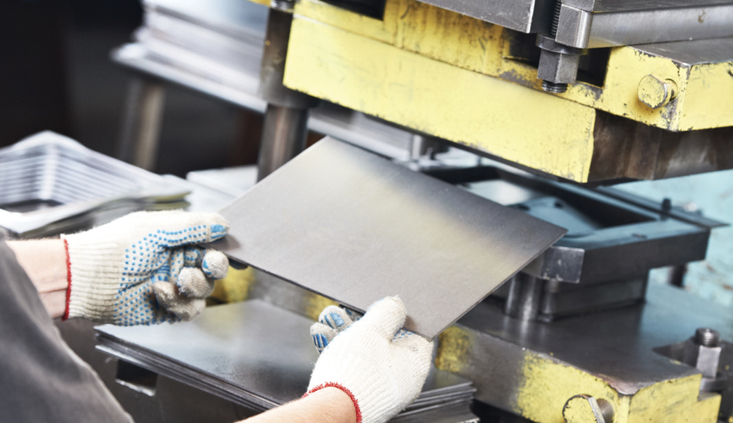The power-press exception to workers’ comp exclusive remedy
It’s a narrow exception that authorizes an employee who suffers a power-press injury to augment the recovery under workers’ comp
Legislative efforts have specifically carved out a very narrow exception to the workers’ compensation exclusive remedy doctrine for civil damages against an employer where the employer has caused and/or prevented its employees from the safe operation of power presses without guards. (See Lab. Code, § 4558). The main question that must be analyzed is whether an injury is encompassed within the purview of the power-press exception, making civil recovery viable. This determination generally is answered in response to a few questions: 1) Is the machine that caused the injury, by definition, a power press?; 2) Was the conduct of removing the guard or not installing it, despite it being required, performed by the employer?; and 3) Did the power- press machine cause the injury to the employee due to a lack of proper guarding?
Workers’ compensation exclusive remedy
Generally, an employee’s rights against his or her employer for injuries suffered on the job lie solely under the workers’ compensation law. (Lab. Code, § 3600). An employer is generally immune from civil damages as the “exclusive remedy” with a no fault system is designed to provide an efficient and readily accessible method of claiming and receiving compensation. (Marsh & McLennan v. Super.Ct. (1989) 49 Cal.3d 1, 6). Because the remedy is fixed by statute, any available recovery may also fall short of what could have been achieved in a traditional civil damage lawsuit.
The power-press exception
The power-press exception authorizes an employee who suffers a power-press injury to augment his or her recovery under the workers’ compensation system. (LeFiell Mfg. Co. v. Superior Court (2012) 55 Cal.4th 275, 286). Any employee may bring a lawsuit for damages against his or her employer where “the employee’s injury or death is proximately caused by the employer’s knowing removal of, or knowing failure to install, a point of operation guard on a power press, and this removal or failure to install is specifically authorized by the employer under conditions known by the employer to create a probability of serious injury or death.” (Lab. Code, § 4558(b)). For an action to survive under section 4558, the party must prove: (a) that the injury or death is proximately caused by the employer’s knowing removal of, or knowing failure to install, a point of operation guard on a power press; and (b) that this removal or failure to install is specifically authorized by the employer under conditions known by the employer to create a probability of serious injury or death.” (Saldana v. Globe-Weis Systems Co. (1991) 233 Cal.App.3d 1505, 1516). There is no liability in the absence of evidence that the manufacturer required or otherwise provided by specification for the attachment of guards on the power press and conveyed this information to the employer in some manner. (Lab. Code, § 4558(c)).
What is a power press?
The first question that must be answered is whether the machine in question falls within the narrow definition of a power press. Labor Code section 4558(a) defines a “power press” as a material-forming machine that utilizes a die designed for use in the manufacture of other products. The determination of whether a machine part constitutes a die is a question for the jury. A die, however, has been referred to as a “tool that imparts shape to material by pressing or impacting against or through the material . . . by punching, stamping or extruding.” (Rosales v. Depuy Ace Medical Co. (2000) 22 Cal.4th 279, 285). Notably, a machine that simply had a cutting head, like a saw, is not by definition a power press. (See Graham v. Hopkins (1993) 13 Cal.App.4th 1483, 1489). In addition, a machine with a die that is not used to manufacture another product, such as a newspaper printer, is not a power press. (McCoy v. Zahniser Graphics (1995) 39 Cal.App.4th 107, 111).
The statutory interpretation of what is a power press is strictly interpreted. Although large power-operated machines of many kinds may present dangers similar to power presses as defined by section 4558, this does not affect the Legislature’s decision to select only certain machines and certain kinds of injury for an exception to the exclusive jurisdiction of the workers’ compensation system. (Rosales v. Depuy Ace Medical Co. supra 22 Cal.4th at 286-87.) Even if guards were required for the safe operation of power lathes as opposed to power presses, section 4558 is strictly construed to be omitted from the statutory exception.
Who is a responsible party under Labor Code section 4558?
Only the employer can be held liable under the narrow exception to the workers’ compensation exclusive remedy. The employer needs to be someone with managerial authority to direct and control the acts of the employee. In addition, the employer must specifically authorize the removal of, or failure to install the guard on the power press. There must be “an affirmative instruction issued by the employer prior to the time of the employee’s physical injury or death, but shall not mean any subsequent acquiescence in, or ratification of, removal of a point of operation safety guard.” (Lab. Code, § 4558(a)(6)). Subsequent acceptance or ratification is not sufficient. (Watters Associates v. Superior Court (1990) 218 Cal.App.3d 1322, 1325).
Moreover, an employer, serving a dual role, who designs, manufactures, and/or installs its own power presses is not excluded from the definition of a “manufacturer” under Labor Code 4558(a) and would be subject to the same liability for its failure to install and/or remove a guard on a power press. By example, manufacturing large power tools for the use by its employees, an employer creates an “extra” employer status or a relationship that subjects it to potential liability as a third-party tortfeasor. (Flowmaster v. Superior Court (1993) 16 Cal.App.4th 1019, 1031). Therefore, the employer would be civilly exposed where it (a) designed the power press calling for a guard that was removed or never installed, or (b) a guard was required to protect the employee against a known risk of serious injury and it was intentionally omitted by the employer from the design, fabrication, or assembly of the press. Notably, however, a manufacturer is not interpreted as one who merely modifies the power press. (Jones v. Keppeler (1991) 228 Cal.App.3d 705).
What kind of guard is required?
The point of operations guard, although not statutorily defined, has been interpreted as any apparatus or device that keeps a worker’s hands outside the point of operation die space while operating a power press. (Bingham v. CTS Corp. (1991) 231 Cal.App.3d 56). Neither the plain language of section 4558 nor case law construing the exception indicates the Legislature intended to incorporate any industry specific definitions of “point of operation guard.” (Lefiell Manufacturing Company v. Superior Court (2014) 228 Cal.App.4th 883, 897).
A machine may also have more than one point of operation that requires a guard on each machine. (Cal.Code Regs., tit. 8, § 4188, subd. (a)). By definition, a “point of operation guard” is required in the area or areas where the die forms the material on a power press. “[T]he Legislature was free to assume that the need for protection was ‘most evident’ in the case of power presses which utilize dies. The Legislature could properly conclude that those machines uniformly present a serious danger to workers when point of operation guards are removed, because they uniformly employ a powerful pressing or stamping motion which can cause serious crush injuries.” (Lefiell Manufacturing Company v. Superior Court, supra 228 Cal.App.4th at 894-96). The point of operation’s guard needs also to be attached to the power press. The use of an unattached device, such as a safety block that the worker moves into and out of the point of operation, is insufficient to serve the function of a safety guard. (See Gonzalez v. Seal Methods, Inc. (2014) 223 Cal.App.4th 405, 410).
How is an employer held liable?
An exception to the exclusivity of workers’ compensation only arises for a power-press injury where the employer has been expressly informed by the manufacturer that a point of operation guard is required, the employer understands the absence of a guard creates a probability of serious injury or death to his employee, and nevertheless either: a) affirmatively removes it; b) or fails to install such a guard despite knowing one should be present.
This narrow carve-out to the workers’ compensation exclusive remedy doctrine was designed to protect workers from employers who willfully remove or fail to install appropriate guards on large power tools that are often difficult to stop while they are in their sequence of operation. Without guarding, employees are grossly exposed to extremely serious injuries. (Ceja v. J.R. Wood, Inc. (1987) 196 Cal.App.3d 1372, 1377).
- Removal of a point of operation guard
Physical removal of a guard designed and manufactured for use on a power press is one way to hold an employer liable outside workers’ compensation. Removal means physical elimination of a point of operation guard from a power press that is installed by the manufacturer or installed by the employer pursuant to the manufacturer’s requirements or instructions despite knowledge that the guard was provided or is required to prevent a real probability of serious injury. (Lab. Code, § 4558(a)(5)). This conduct by the employer must be specifically authorized as an affirmative instruction to remove the guard given by the employer prior to the injury or demise of the worker. It does not mean a subsequent compliance or ratification by the employer. (Lab. Code § 4558(a)(6)).
Under section 4207, subdivision (a)(4) of the California Code Regulations, physical removal means that “[a] hand tool such as a box, open end or adjustable wrench, socket or key wrench shall be required to remove the guard.” Physical removal, for the purpose of liability under section 4558, means to render a safeguarding apparatus, whether a device or point of operation guard, dysfunctional or unavailable for use by the operator for the particular task assigned. (Bingham v. CTS Corp., supra 231 Cal.App.3d at 68).
- Failure to install point of operation guard
A second basis for holding an employer liable under the power-press exception to workers’ compensation exclusive remedy is where the employer fails to install a point of operation guard when the attachment is required by the manufacturer and made known to the employer at the time of acquisition, installation, or manufacturer-required modification of the power press. (Lab. Code, § 4558(a)(2)).
- Actual knowledge is required for the power-press exception
The knowledge required is “actual awareness” by the employer rather than merely constructive knowledge. A worker must prove the employer knew a guard was required to prevent probability of serious injury or death. It is not sufficient merely to show that injury was negligently and proximately caused by absence of the guard.
It appears that the Legislature has used the word “known” under section 4558 in the sense of actual awareness. Nothing in the statute indicates that the courts may impute knowledge or impose constructive knowledge. (Dowden v. Industrial Acc. Com. (1963) 223 Cal.App.2d 124, 129). “Absent facts which would establish the employer’s knowledge or action regarding the absence of a point of operation guard on a power press, the incident would not come within the exception of section 4558, and an employee would be precluded from bringing a claim under the power-press exception. (Flowmaster, Inc. v. Superior Court, supra, 16 Cal.App.4th at 1032).
Although very narrow, the power- press exception is of critical importance in the context of the no-fault workers’ compensation system as it prevents the employer from shielding itself behind the workers compensation exclusive remedy, and holds them liable for all resultant damages. The reason is simple — the point of operation where a guard is required is the most common area of injury to employees. Requiring employers to safeguard foreseeable risks of injury to their employees where a guard is required is one step closer to holding them accountable.
Brian S. Kabateck

Brian S. Kabateck is a consumer rights attorney and founder of Kabateck Brown Kellner LLP. He represents plaintiffs in personal injury, mass torts litigation, class actions, insurance bad faith, insurance litigation and commercial contingency litigation.
Douglas A. Rochen

Douglas A. Rochen is a senior associate in the personal injury division of Kabateck Brown Kellner LLP. Mr. Rochen has extensive experience in personal injury cases, including product liability, catastrophic injury, toxic tort, premises liability, and pharmaceutical litigation. He also focuses on commercial litigation, habitability disputes, and consumer fraud cases.
Copyright ©
2026
by the author.
For reprint permission, contact the publisher: Advocate Magazine

